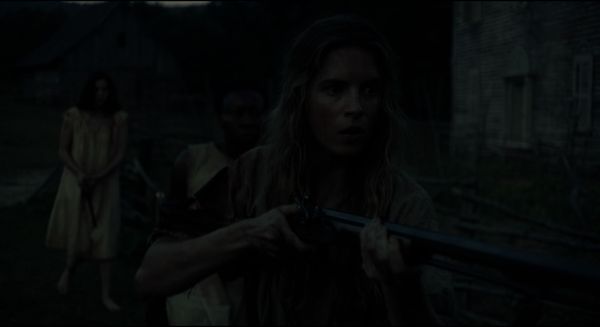Eye For Film >> Movies >> The Keeping Room (2014) Film Review
The Keeping Room
Reviewed by: Owen Van Spall

The tropes and iconography of the American Civil War and the Western get reworked in Daniel Barber’s handsomely mounted, atmospheric southern-set thriller that interrogates issues of gender, race and the headlong rush of war and progress that was America in its civil war period. Instead of taking us to the frontlines of the blue and grey, Barber places three female characters at the centre of the plot - two sisters and their black slave - and locates them in a worn-out South Carolina clapboard mansion that has, so far, been kept away from the war.
The sisters, Augusta (Brit Marling, Another Earth) and Louise (Hailee Steinfeld, True Grit), have been stuck for years now together with the family’s African American slave Mad (Muna Otaru) Though the menfolk are gone, visible only to the younger Louise in fevered nightmares where they stumble in piles of corpses, the farm appears to be keeping above water. Barber and cinematographer Martin Ruhe create a vivid picture of this beautiful-yet-tough setting: towering trees, long shadows and scattered wooden outposts that seems to all be on another planet. The war seems a very, very long way away from this dreamlike land. But as the opening text of the film - a quote from Union General Sherman, who controversially burned his way through the southern states in order to shock the populace into peace - makes clear, the war is looming over the horizon for these women. When it finally catches up with them, it is manifest in the form of a pair of murderous Union “Yankee” scouts (Sam Worthington and Kyle Soller) who desire no less than to pillage and rape and who follow Augusta home from a trip to the nearest store.
With the women soon besieged at the mansion by these armed soldiers and with no outside help coming, elements of a home invasion thriller are brought into play, with suitably sharp explosions of action in and outside the mansion, intercut with tense moments of hunting and waiting, taking up much of the film’s second half. Eventually the women shift from defenders to hunters under Augusta’s assured leadership (she is competent with a carbine and a fine rider), the race barriers between them brushed aside in the larger fight for survival. The men themselves seem more demonic, allegorical figures than real people. Worthington’s character, who develops a rapport of sorts with Marling’s Augusta, seems unable to clearly explain why he is pursuing them, except that he long ago “forgot how to stop”.
Here it seems the film wants to show us the tragic fallout of the war for both men and women, a war which might have ended in the unification, rapid industrialisation and ultimate global domination of America, but which has demanded that the price be a generation of men given free reign to unleash their primal impulses. Or perhaps the war, visible eventually to the women over the treetops as a fiery glow from the frontlines, is the unending patriarchy itself made horribly manifest in cannon, fire and steel. Against this, the differences between the three women matter little. As Marling’s character says at one point (a line perhaps a little too on the nose) : “We are all N****s now”.
Apart from the striking visuals (see the burning carriage long shot in the opening minutes), an interesting historical lens through with which to look at this tale, and some welcome genre references, the film also boasts an arresting central performance from Marling as the feisty Augusta. But the film is not quite as effective at exploring the dynamics and themes of gender, race and slavery within the house as as it is at creating a tangible mood of creeping danger outside it. This is partly because the other two female roles, though well acted by Steinfeld and Otaru, feel underwritten in screenwriter Julia Hart’s script. Still, this is an artfully constructed and effective thriller with a feminist spine.
Reviewed on: 20 Oct 2014















